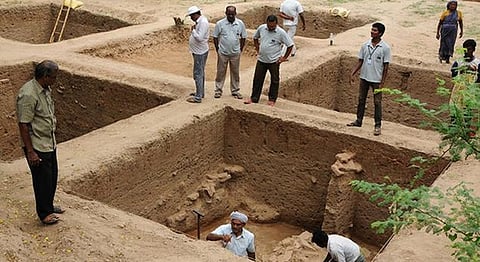
- HOMEGROWN WORLD
- #HGCREATORS
- #HGEXPLORE
- #HGVOICES
- #HGSHOP
- CAREERS
- ABOUT US
- CONTACT US

Under the leafy covers of the vast private coconut farm of Keeladi village in Madurai, Tamil Nadu, lies a 3rd Century BC settlement. Said to be around 3000 years old, the second part of the excavation has revealed that it could be as big as the Harappa Civilisation.
In a new revelation by the Archaeological Survey of India (ASI) stationed in the village, more than 80 acres of land stand as proof of Sangam Era lives. The branch VI of Bangalore that chose this village for excavation believe it to be the same size as Harappa and Mohenjodaro excavations with traces of an urban structure and facilities. In a report by Deccan Chronicle, ‘according to ASI officials, the ancient settlement at the village, which was on the highway travelled by traders all over the world once, had an underground drainage system which was on par with the Harappan system. The sewage drains had been laid with “baked clay pipe lines”. Apart from extracting signets with traders’ seals, ornaments and weapons, officials have found proof of the ancient Madurai-Pandiya era which could shed more light on the Sankakal Tamil civilization.’
With pottery and walls having inscriptions of Tamil Bhrami Script and apparent trade ties with the Roman Empire, this news could rewrite Tamil and Indian history. The Sangam era that lasted till 4th Century A.D is replete with tales of yore by poets and scholars of Madurai from that time.
53 excavations later, many believe the stories from Sangam literature have found proof of their validity. “The mound where we are excavating is of 3.5 km circumference in 80 acres of private agricultural land. We are finding structure after structure of the habitation site, the first of its kind in Tamil Nadu. It could be a huge urban settlement of independent civilisation on the banks of the river Vaigai,” said K Amarnath Ramakrishna, superintending archaeologist in an interview with Times of India.
In the first phase of excavation carried out in 2015, ASI officials found proof of an ancient human habitat in this village. The found brick walls, pottery, ornaments, shells, glasses and separate living quarters of the wealthier inhabitants. In a post by The Better India, things like beads of agate, arretine pot shreds, and quartz found from this region also highlights that the people had trade links with western countries. Looks like most of the poems, stories and literature of this famous period could be a lived reality rather than fiction.
Feature Image Courtesy: G. Moorthy/ The Hindu. All photos courtesy: The Hindu
